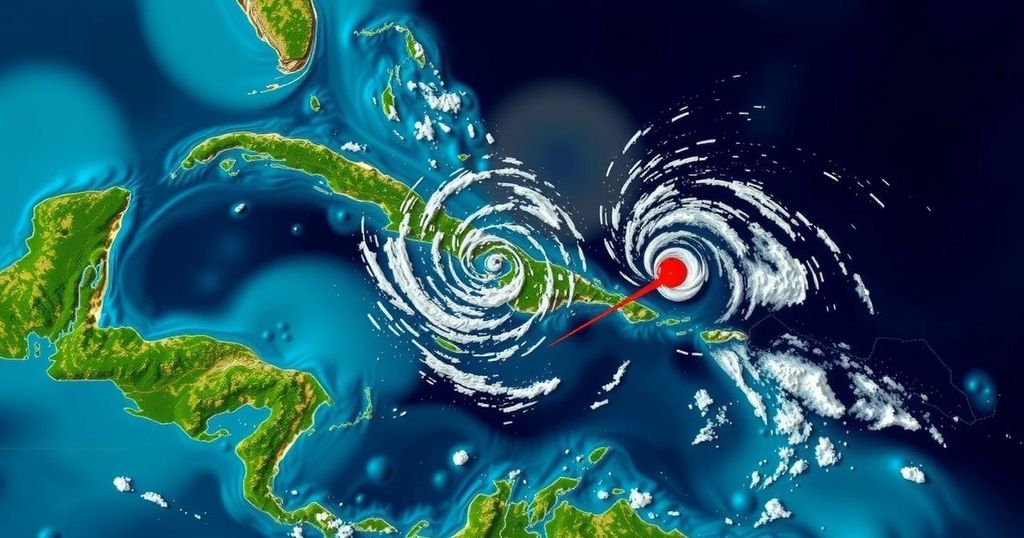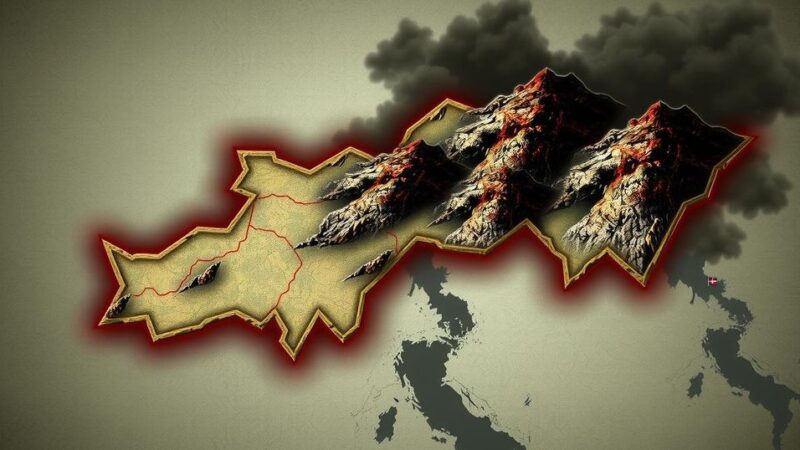Tropical Storm Oscar advanced toward the Bahamas after making landfall in Cuba as a Category 1 hurricane, resulting in six fatalities due to heavy rains and flooding. The storm, which has a small wind field, was noted for surprising meteorologists with its unexpected intensity. Rainfall predictions indicated potential flooding in the Bahamas, while Oscar became the 15th named storm of the Atlantic hurricane season, with considerations of above-average storm activity this year.
Tropical Storm Oscar progressed toward the Bahamas on Tuesday following its impact on Cuba as a Category 1 hurricane, resulting in the death of at least six individuals due to extensive rainfall and flooding. At the time of the report, Oscar was situated approximately 45 miles (75 kilometers) south-southeast of Long Island in the Bahamas, generating sustained winds of 40 mph (65 kph) and moving north-northeast at a speed of 12 mph (19 kph), as per the National Hurricane Center’s latest updates. Currently classified as a tropical storm, Oscar was anticipated to produce up to 5 inches (13 centimeters) of rain across the southeastern Bahamas, with isolated regions potentially receiving as much as 8 inches (20 centimeters). A tropical storm warning had been issued for the central and southeastern areas of the Bahamas. Remarkably, Oscar made history as the smallest recorded hurricane, with a wind field measuring merely 6 miles (10 kilometers) across, surprising many meteorologists with its unexpected development into a hurricane during its landfall on Grand Inagua Island and subsequently in eastern Cuba. Storm surge expert Michael Lowry remarked on the unprecedented nature of the situation, highlighting significant inaccuracies in hurricane forecasting regarding Oscar’s unexpected strengthening. The storm unleashed torrents of rain in eastern Cuba, with some areas experiencing 15 inches (38 centimeters), prompting warnings of severe flooding and potential landslides in the region, specifically contributing to six fatalities reported in Guantánamo. The timing of the storm coincided with Cuba’s ongoing recovery from a severe power outage, which had sparked demonstrations and a firm government warning against civil unrest. Oscar represents the 15th named storm and the 10th hurricane of the current Atlantic hurricane season, which commences on June 1 and concludes on November 30. The National Oceanic and Atmospheric Administration forecasted an above-average Atlantic hurricane season, predicting between 17 to 25 named storms and four to seven major hurricanes of Category 3 or higher. In the Pacific, Tropical Storm Kristy was also monitored, located 375 miles (605 kilometers) west-southwest of Acapulco, Mexico, with expectations of developing into a hurricane by nightfall. This report serves to encapsulate the critical developments associated with Tropical Storm Oscar and its implications for the affected regions, particularly in terms of weather forecasting accuracies, environmental challenges, and ongoing humanitarian concerns due to power outages and flooding.
The article discusses the recent developments surrounding Tropical Storm Oscar, which transitioned from a hurricane to a tropical storm as it approached the Bahamas after impacting Cuba. It provides details on the storm’s trajectory, its effects on local weather patterns, and the ensuing challenges faced by populations in the storm’s path. The backdrop includes concerns over power outages in Cuba and the broader context of the Atlantic hurricane season, characterized by predictions of above-average activity due to warm ocean temperatures. This situation highlights the importance of accurate weather forecasting, emergency preparedness, and the environmental implications of extreme weather events.
In conclusion, Tropical Storm Oscar serves as a significant case study in hurricane dynamics, exemplifying the unexpected nature of storm behavior and the challenges posed by natural disasters. Its impact, marked by fatalities and severe weather conditions in Cuba and the Bahamas, underscores the necessity for improved forecasting methods and enhanced emergency response strategies. As the Atlantic hurricane season progresses, attention to such storms remains crucial for ensuring public safety and preparedness.
Original Source: www.washingtontimes.com






